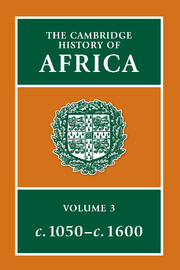Book contents
- Frontmatter
- Introduction: some interregional themes
- 1 Egypt, Nubia and the Eastern Deserts
- 2 Ethiopia, the Red Sea and the Horn
- 3 The East Coast, Madagascar and the Indian Ocean
- 4 The eastern Maghrib and the central Sudan
- 5 The western Maghrib and Sudan
- 6 Upper and Lower Guinea
- 7 Central Africa from Cameroun to the Zambezi
- 8 Southern Africa
- 9 The East African interior
- Bibliographical Essays
- Bibliography
- Index
- References
1 - Egypt, Nubia and the Eastern Deserts
Published online by Cambridge University Press: 28 March 2008
- Frontmatter
- Introduction: some interregional themes
- 1 Egypt, Nubia and the Eastern Deserts
- 2 Ethiopia, the Red Sea and the Horn
- 3 The East Coast, Madagascar and the Indian Ocean
- 4 The eastern Maghrib and the central Sudan
- 5 The western Maghrib and Sudan
- 6 Upper and Lower Guinea
- 7 Central Africa from Cameroun to the Zambezi
- 8 Southern Africa
- 9 The East African interior
- Bibliographical Essays
- Bibliography
- Index
- References
Summary
THE FATIMIDS
The Fatimid conquest of Egypt in AD 969 was accomplished without much difficulty, as the country had for some time already been in internal chaos and had suffered heavily from famines. The skilful political and religious propaganda of the Fatimids also prepared the ground for a ready acceptance of the new dynasty by the population. When the Fatimid general Jawhar (a former slave of Dalmatian origin), after overwhelming the last feeble resistance of the Ikhshidid army, entered al-Fustāt on 1 July 969 and formally proclaimed the new regime by introducing the khutba (Friday sermon) in the name of his master, the caliph al-Mu'izz (952–75), the event had a more profound significance and more far-reaching consequences than a simple change of dynasty so common in the annals of the Islamic world. The coming of the Fatimids marked a new epoch in the history of Egypt which, for the first time since the Ptolemies, became not only the seat of a completely sovereign dynasty, but also the centre of an empire that survived its original founders and lasted for more than five centuries.
The imperial idea was, indeed, inherent in the Ismā'ili ideology, of which the Fatimids were the most prominent champions, and only they, among all the Ismā'ili Shi'a branches, came within reach of attaining the ecumenical goal of the doctrine. They considered their North African period merely a preparatory stage, and the conquest of Egypt only one of the stepping-stones, on the road to the creation of the universal Ismā'ili empire, ruled by the Prophet's descendants in accordance with the esoteric doctrine of the Ismā'iliya.
- Type
- Chapter
- Information
- The Cambridge History of Africa , pp. 10 - 97Publisher: Cambridge University PressPrint publication year: 1977



